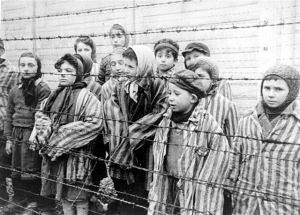How Nazism Shaped US War Policies: Thousands of SS War Criminals Recruited to the U.S. by CIA-Pentagon after WWII

This essay is dedicated to Mohamedou Slahi, author of Guantánamo Diary. Slahi has been imprisoned at the detention camp at Guantánamo Bay, Cuba since 2002. In all these years, the United States has never charged him with a crime. A federal judge ordered his release in March 2010, but the U.S. government fought that decision, and there is no sign that the United States plans to let him go. It is also an homage to investigative journalists.
It’s all starting to fit together for me after reading Eric Lichtblau’s The Nazis Next Door: How America Became a Safe Haven for Hitler’s Men. Like most children of the 60s, I grew up believing in the Hollywood version of WWII—that the U.S. fought Hitler’s brutal forces of fascism from spreading across the face of the earth and brought it to an end.
Check out our public schools’ history books and you’ll discover that an important part of the victory has been intentionally omitted: Russia deserved a good deal of the credit for beating back the Nazis. Millions of Russians died fighting Hitler’s vicious war machine. Indeed, Victory Day, May 9th, is hugely celebrated in Russia every year. However, ask most American high school students if they know the significance of May 7th or the 9th and predictably you’ll be met with a bunch of blank faces. Moreover, the Russians were partly responsible for having liberated victims of concentration camps. The truth is that the partnership between the U.S. and Russia finished off Hitler’s Third Reich for good. Like most Americans, I believed that Nazism came to an end on Victory Day, 1945.
But some fifty years later, thanks to the hard work of investigative journalist, Eric Lichtblau, including journalists in the 60s and 70s that were hounded by the CIA and J. Edgar Hoover’s FBI, for what they discovered, we’re learning more about the appalling truth on what actually happened after WWII.
In Lichtblau’s The Nazis Next Door, I learned how the CIA-Pentagon eagerly recruited “ten thousand SS officers from top Third Reich policymakers, including sixteen hundred Nazi scientists and doctors with direct links to Nazi atrocities.” The Pentagon-CIA helped to "cleanse" their war records under the top secret document known as “Project Paperclip.” As Lichtblau explained, it was far easier to enter the US if you held SS Nazi credentials than if you were a victim of Hitler’s persecutions. The government provided thousands of the most heinous Nazi torturers and murderers “visas, houses, offices, and research assistance.” Lichtblau revealed that the horrific war crimes committed by the Nazis were of no concern to the U.S. government. The feds wanted the information that resulted from SS Nazi operations.
While Nazis were being secretly welcomed into our country, most victims of the Holocaust were denied entrance to the U.S. with very few exceptions. “Holocaust survivors were denied visas en masse while Nazi collaborators and SS members of Hitler’s reign of persecution, men who had proudly worn the Nazi uniform, were often able to enter the United States as war refugees who ended up living long, happy, prosperous lives.”
I think of one example from many given in Lichtblau’s first chapter: a top Nazi cabinet minister responsible for ordering the murder and imprisonment of some 600,000 of his countrymen, known as the “Butcher of the Balkans,” and how he happily entered the United States, no problems, compliments of the CIA and U.S. immigration officials, and how he became “simply another visitor traveling . . . ”
I believe this is a very important book to read not only for the sake of setting the record straight on this dark chapter in our history, but because it also raises the infamous question: Did those thousands of Nazis that were allowed to work in the Pentagon and the CIA help to shape U.S. foreign and domestic policies after WWII?
All you have to do is read the CIA’s Torture Report and then compare notes with the criminal Nazi war policies: the practice of torture, illegal invasions, presidential assassinations of individuals that the U.S. President chooses to kill, including U.S. citizens, without trial, due process or burden of proof, psychological warfare, intrusive and illegal surveillance of national and international phone calls, e-mails, text communication, computers, homes, extraordinary rendition i.e. illegal kidnappings, locking prisoners up as “enemy combatants,” which means that they are denied all judicial and legal rights, prosecutions of ethical journalists/whistle-blowers, secret CIA black cells in which the same torture techniques that were used on Holocaust victims were-are applied to detainees, and worst of all: medical experimentation on human beings, “detainees,” to see how much pain and suffering they can endure. Many were murdered from the intensified torture practices.
As Mike Lofgren explained in his recent article "The Implication of the Torture Report":
“Chillingly, ‘enhanced interrogation’ is a literal translation of the German verschärfte Vernehmung, a term introduced by a Gestapo directive of June 12, 1942, to describe permissible methods of interrogating prisoners. Post-World War II war crimes tribunals judged the techniques described in the directive—techniques strikingly similar to those employed six decades later by the CIA—to be war crimes. It should also be noted that a Japanese sergeant at Changi Prison in Singapore was sentenced to 20 years at hard labor after World War II for waterboarding prisoners.”
Over the years I’ve struggled with the conclusion that the U.S. occupations, surveillance, and torture policies have made us look like the bad guys in the eyes of the world. And it seems that our soldiers have been struggling with that same question as well. In addition to physical wounds, the mental wounds of fighting continuous wars have led to drug addictions and suicides. Twenty-two U.S. veterans commit suicide a day, a toll that has surpassed the number of soldiers killed in combat.
But here’s the worst of it. Historians have often asked the question: How could the German people allow someone like Hitler to rise to power? Why did they eagerly applaud Hitler’s racist speeches of hate and bigotry like sheep? Someday, historians will ask the same questions about the American people and their government concerning U.S. torture prisons at Abu Graib and Guantánamo Bay. Will Americans care? Will they be outraged that these crimes against humanity were committed in their names? Will they strongly demand an end to the CIA-wars? Inevitably, I fear the answer to those questions. And that, perhaps, is the most disturbing revelation of all.
Selected quotes are from Eric Lichtblau’s book The Nazis Next Door: How America Became a Safe Haven for Hitler’s Men.
Eric Lichtblau is a New York Times investigative reporter in Washington. In 2006 he won a Pulitzer Prize for stories on the NSA’s secret wiretapping operations. He is the author of Bush’s Law: The Remaking of American Justice.
The first photo is from rarehistoricalphotos.com, and focuses on a Jew about to be shot in front of a mass grave in Vinnitsa, Urkraine. It comes from an Einsatzgruppen soldier's personal album.
The second image originates from the United States Holocaust Memorial Museum, courtesy of Belarussian State Archive of Documentary Film and Photography.
The last illustration is by Anthony Tremmaglia. He is an Ottawa-based illustrator, artist, and educator. His clients include WIRED, Scientific American, Smart Money, HOW, and San Francisco Weekly.
Recommended
Nor’easter
Post-Op Appointment With My Father
Cedar Valley Youth Poet Laureate | Fall 2024 Workshop





